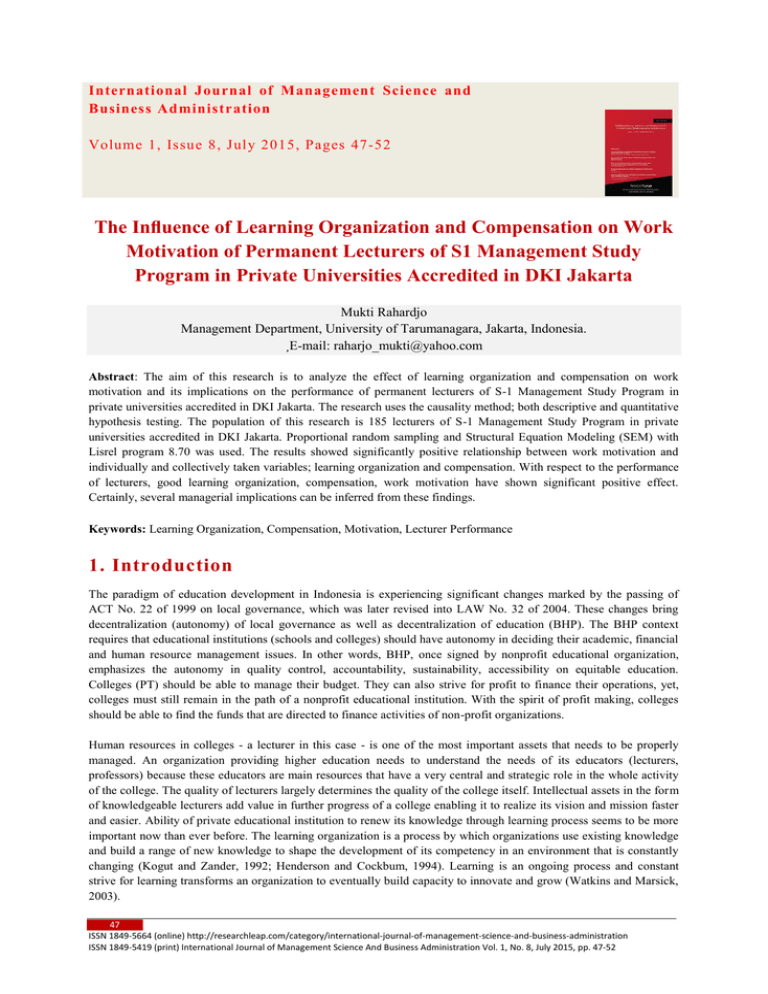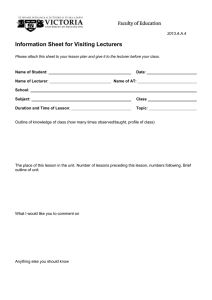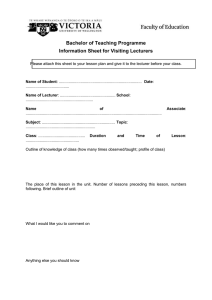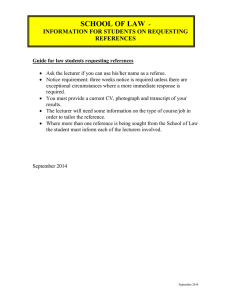The Influence of Learning Organization and
advertisement

International Journal of Management Science and Business Administration Volume 1, Issue 8, Jul y 2015, Pages 47-52 The Influence of Learning Organization and Compensation on Work Motivation of Permanent Lecturers of S1 Management Study Program in Private Universities Accredited in DKI Jakarta Mukti Rahardjo Management Department, University of Tarumanagara, Jakarta, Indonesia. ¸E-mail: raharjo_mukti@yahoo.com Abstract: The aim of this research is to analyze the effect of learning organization and compensation on work motivation and its implications on the performance of permanent lecturers of S-1 Management Study Program in private universities accredited in DKI Jakarta. The research uses the causality method; both descriptive and quantitative hypothesis testing. The population of this research is 185 lecturers of S-1 Management Study Program in private universities accredited in DKI Jakarta. Proportional random sampling and Structural Equation Modeling (SEM) with Lisrel program 8.70 was used. The results showed significantly positive relationship between work motivation and individually and collectively taken variables; learning organization and compensation. With respect to the performance of lecturers, good learning organization, compensation, work motivation have shown significant positive effect. Certainly, several managerial implications can be inferred from these findings. Keywords: Learning Organization, Compensation, Motivation, Lecturer Performance 1. Introduction The paradigm of education development in Indonesia is experiencing significant changes marked by the passing of ACT No. 22 of 1999 on local governance, which was later revised into LAW No. 32 of 2004. These changes bring decentralization (autonomy) of local governance as well as decentralization of education (BHP). The BHP context requires that educational institutions (schools and colleges) should have autonomy in deciding their academic, financial and human resource management issues. In other words, BHP, once signed by nonprofit educational organization, emphasizes the autonomy in quality control, accountability, sustainability, accessibility on equitable education. Colleges (PT) should be able to manage their budget. They can also strive for profit to finance their operations, yet, colleges must still remain in the path of a nonprofit educational institution. With the spirit of profit making, colleges should be able to find the funds that are directed to finance activities of non-profit organizations. Human resources in colleges - a lecturer in this case - is one of the most important assets that needs to be properly managed. An organization providing higher education needs to understand the needs of its educators (lecturers, professors) because these educators are main resources that have a very central and strategic role in the whole activity of the college. The quality of lecturers largely determines the quality of the college itself. Intellectual assets in the form of knowledgeable lecturers add value in further progress of a college enabling it to realize its vision and mission faster and easier. Ability of private educational institution to renew its knowledge through learning process seems to be more important now than ever before. The learning organization is a process by which organizations use existing knowledge and build a range of new knowledge to shape the development of its competency in an environment that is constantly changing (Kogut and Zander, 1992; Henderson and Cockbum, 1994). Learning is an ongoing process and constant strive for learning transforms an organization to eventually build capacity to innovate and grow (Watkins and Marsick, 2003). 47 ISSN 1849-5664 (online) http://researchleap.com/category/international-journal-of-management-science-and-business-administration ISSN 1849-5419 (print) International Journal of Management Science And Business Administration Vol. 1, No. 8, July 2015, pp. 47-52 Mukti Rahardjo The Influence of Learning Organization and Compensation on Work Motivation of Permanent Lecturers of S1 Management Study Program in Private Universities Accredited in DKI Jakarta Creating learning organization as core competency and helping employees of the organization to celebrate their success in this particular educational institution largely depends on compensation being paid to the work of this employee. According to Rivai (2007: 117), compensation is all the income in the form of money, goods directly or indirectly received by the employee in return for the services they rendered in the company. The magnitude of the compensation reflects the status, recognition and fulfillment level enjoyed by employees. Therefore, compensation factors need to be well considered by the private universities in order to improve the lecturers’ performance. Compensation factor itself may not be enough meaning that private universities must also pay attention to motivation factors. There should be means of motivation to drive lecturers to work diligently so that they try to do their job maximally among their peers. What is more, there also should be discipline set under the leadership of the organization so that the goal can be achieved under the atmosphere conducive to the better work. Based on the above description, the researcher intends to elucidate influence of learning organization and compensation, motivation on the performance of the lecturers. We check the impact of above-mentioned factors on lecturer’s performance and motivation taking lecturers working at S-1 Management courses in an accredited private University in Jakarta as our sample. Thus, research questions of this study are as follows: 1. What is the impact of learning organization on the work motivation of the lecturer? 2. Does compensation affect work motivation of lecturers? 3. Does learning organization and compensation affect motivation of the lecturer? 4. Does learning organization affect performance of lecturers? 5. Does compensation affect performance of lecturers? 6. What is the effect of motivation on performance of lecturer? 7. Do learning organization, compensation and motivation have an effect on the performance of lecturers? 2. Literature review Senge (2002: 3) defines learning organizations as organizations where people continually expand their capacity to achieve results they truly desire, where new and expansive patterns of thinking are nurtured, where collective aspiration is set free and where people continually learn to see the whole together. This means that the learning organization as an individual organization develop the capacity to create the results they want through new and development thinking and collective aspirations evolve freely and individuals continuously seek for ways to study together. Watkins and Marsick (2003: 118) states: “Learning organizations are characterized by total employee involvement in a process of collaboratively conducted, collectively accountable change directed towards shared values or principles”. Jones (2007: 341) states that the learning organization is the organization with the purpose of designing and building structures, culture and organizational strategies that can enhance and maximize potential learning that occurs within the organization. According to Garvin (Certo, 2009: 68), learning organization is an organization that does well in creating, acquiring and transferring knowledge and modifying behavior to reflect new knowledge. According to Dessler (2005: 187), compensation is any form of payment or rewards given to employees and employees. Compensation has two aspects: first, direct financial payments in the form of wages, salaries, incentives, commissions, and bonuses; second, indirect payment in the form of financial allowances, such as insurance, paid vacation and etc. Milkovich and Newman (2005: 6) define the compensation as follows: “compensation refers to all forms, of financial returns and tangible services and benefits employees receive as part of an employment relationship”. There are various forms of payment as tribute upon exertion of a worker: (a) cash compensation in the form of base salary, salary increases, incentives as well as periodic adjustments to the price increase, and (b) welfare payments in the form of retirement savings, insurance, family allowances and health benefits (Milkovich and Newman (2005: 7)). Awards in the form of money are referred as relational; these are returns made for recognition and status, a sense of security in work. Relational return is analogous to psychological reward. Total compensation on the other hand is in more transactional nature meaning it is a transaction between employee and employer. This is to remind to the employee that are able to achieve desired results dedicating their energy and full intellect to the prosperity of the organization. Motivation is a condition or energy that drives employees to achieve organizational goals in the company (Mangkunegaran (2007: 61)). It is mental attitude of employees against work situation, their positive strength to perform well and achieve the maximum. Giving motivation to the worker to make him/her do normal work is complicated, because it involves individual factors and organizational measures. According to Gomes (2003: 181), individual factors derive from employee’s natural needs, life objectives, 48 ISSN 1849-5664 (online) http://researchleap.com/category/international-journal-of-management-science-and-business-administration ISSN 1849-5419 (print) International Journal of Management Science And Business Administration Vol. 1, No. 8, July 2015, pp. 47–52 Mukti Rahardjo The Influence of Learning Organization and Compensation on Work Motivation of Permanent Lecturers of S1 Management Study Program in Private Universities Accredited in DKI Jakarta attitudes and skills. Organizational factors of motivation can be in the form of payments or salary, job security, fellow workers. Organizational factors are such factors that give rise to employee encouragement; supervision, guidance, praise and etc. Mangkunegara (2007: 74) argues that the factors that influence employee motivation differs inferring from differences in individual, job and organizational characteristics: (a) individual characteristics include differences in the needs, interests, attitudes and values; (b) differences in characteristics of job is related to the terms and conditions of the offered job, job placement in accordance with the field of employee expertise; (c) differences in the characteristics of the organization include differences in work environment which includes the regulation of work, working climate and culture of work agreed. Hasibuan (2007: 65) suggests that the performance is a collection of number of physical and mental activity involved to do the job. Rivai (2007: 309) defines that performance is a function of motivation and ability. To complete a task or a job, a person should have a degree of willingness and a level of certain skill. The willingness and the skills of a person is not enough without clear understanding of what will be done and how it is done. Performance is a behavior of showing everyone achievements of work accomplished by employees in accordance with the requirements of the company. Employee performance is a important for the company to reach targeted goals. Performance assessment is a way of measuring the contributions of individuals to the organization (Gomes (2003: 135)). As Mangkunegara (2007: 69) states, performance assessment is a process of assessment of the achievements of employees on work assigned systematically by company leaders. Performance of lecturers is crucial given that lecturers are one of the most essential components in a system of education in college. Accomplishment of the roles, duties, and responsibilities by lecturers is very important in realizing the goals of Indonesian national education; the intellectual life of the nation, human quality of Indonesia, quality of faith/noble morals, piety, mastery of science, technology, and art, realization of an advanced society of Indonesia. Evaluation of the main tasks of lecturer aims to (1) enhance the professionalism of lecturers in carrying out given tasks, (2) improve the processes and outcomes of education (3) assess the performance accountability of lecturer (4) improve academic atmosphere at colleges and all levels (5) acceleration of national educational goals (Department of higher education, 2010). The evaluation was carried out on a periodic basis meaning that evaluation is done on each fixed period. This is to maintain accountability of the performance of colleges in front of stakeholders. Evaluation of the activities was done at Tridharma College in the field of (1) education and teaching, (2) research and development papers, (3) community and devotion (4) other supporting activities. 3. Methodology The type of research used is descriptive. Sekaran Uma (2006: 121) states that descriptive research aims to describe variables in certain situations. According to Maihotra (2007: 85), research verification or causality is done to test the truth of causal relationships (cause and effect), the relationship between the independent variable (affecting) and the dependent variable (the affected). This research aims to test and analyze causal relationships between exogenous and endogenous variables, as well as examine the validity and reliability of the overall research instruments. Structural analysis techniques -Equation Modeling (SEM) – were used applying Lisrel statistical program, SPSS version 8.70 and 19.0. The population of the research is 185 lecturer respondents working in the private University in Jakarta District. Sampling techniques used in the research is proportional random sampling. 4. Results and discussion We show the output from math model analysis results done by the help of SPSS and Lisrel statistical program below. The coefficient of the learning organization to work motivation of lecturers demonstrate the value of non-standardized coefficient of 0.338 and T-count amounted to 2.7 14. The values obtained to qualify for receipt of Hi values T-count of 1.96. It can be inferred here that learning organization has a significantly positive effect on lecturer’s work motivation. Path coefficient compensation with respect to lecturer’s motivation showed the value of the coefficient of 0.256 standardized and T-count of 1,994. The values obtained to qualify for receipt of Hi values T-count of 1.96. It can be inferred here that compensation has a significantly positive influence on lecturer’s motivation work to. 49 ISSN 1849-5664 (online) http://researchleap.com/category/international-journal-of-management-science-and-business-administration ISSN 1849-5419 (print) International Journal of Management Science And Business Administration Vol. 1, No. 8, July 2015, pp. 47–52 Mukti Rahardjo The Influence of Learning Organization and Compensation on Work Motivation of Permanent Lecturers of S1 Management Study Program in Private Universities Accredited in DKI Jakarta Figure 1. The Path of the Structural Model Research (Standardized Solution) Figure 2. The Path of the Structural Model Research (T-Value) The equation obtained for lecturer’s work motivation model through value nonstandard estimate is as follows: MOT 0.338 * LO + 0.256 * KOM 0.259, R2 R square means variation in lecturer’s work motivation described by a learning organization and compensation totaling to 25.90%. The remaining 74.10% of other influencing factors has not been examined in the model. The coefficient of the learning organization to lecturer’s performance shows fixed nonstandard coefficients of 0.257 and T-count of 2.126. The values obtained to qualify for receipt of Hi values T-count of 1.96. Thus, it can be inferred that organization learning has a significantly positive effect on lecturer’s performance. 50 ISSN 1849-5664 (online) http://researchleap.com/category/international-journal-of-management-science-and-business-administration ISSN 1849-5419 (print) International Journal of Management Science And Business Administration Vol. 1, No. 8, July 2015, pp. 47–52 Mukti Rahardjo The Influence of Learning Organization and Compensation on Work Motivation of Permanent Lecturers of S1 Management Study Program in Private Universities Accredited in DKI Jakarta The coefficient of the effectiveness of the compensation shows the value of the coefficient of 0.270 nonstandard and Tcount of 2.330. The values obtained to qualify for receipt of Hi values T-count of 1.96. Thus, it can be inferred that compensation has a significantly positive influence on lecturer’s performance. The coefficient of the motivation towards lecturer’s performance shows the value of the coefficient of nonstandard 0.391, T-count of 2.910. The values obtained to qualify for receipt of Hi values T-count of 1.96. Thus, it can be inferred that motivation has a significantly positive influence on lecturer’s performance. The equation obtained from lecturer’s performance model through value nonstandard estimate is as follows: PERF 0.391 * MOT + 0.257 * LO + 0.270 * KOM, R2 - 0.534 R square means variation in lecturer’s performance described by a learning organization and compensation totaling to 53,40%. The remaining 46.60% of other influencing factors has not been examined in the model. Based on research results following conclusions can be drawn: Organizational learning has been proven to have significantly positive effect and number of performance variation R square described learning, work motivation and the rest 46,60 toward Motivation against a lecturer, with the acquisition of 0,338 coefficients and t t > 2,714 count table 1.96. Today the most influential tool is a learning organization and its empowerment of its individuals. Compensation proved to be positively and significantly influential to Working with professors, motivation the acquisition value of the coefficient of 0.25 6 and the value t calculate 1,994 > t table 1.96. As for the dimensions that are influential and variables compensation is the power and mind. Organizational learning and compensation have been proven to be positively and significantly related to work motivation of the lecturer; F value 33,718 > F. The conclusion is made based on the results of examine The GOF criteria has fulfilled the criteria the assumptions that required SEM. Model structural equation obtained are: MOT = 0.338 * LO + 0.256 * KOM, Errorvar = 0.741, R2 = 0,259. It shows the value of the coefficient of determination R 2 0.25 9 indicating that Learning organization and Providing compensation the contribution of 25.90% to increase Motivation Work of the Lecturer. As for dimensions the most influential and variables of learning organization individual empowerment with the involvement of indicators individuals in job assignments and responsibilities that is distributed. Organization of learning proved a positive and significant effect Keep, Lecturer on performance with the acquisition of the value of the coefficient 0,257 and t t > 2,126 count table 1.96. As for the dimensions that are most influential and variables learning organization is empowerment of individuals (Figure 5.18 5.26, table). Compensation proved to be influential positively and significantly, with the Lecturer's performance the acquisition value of the coefficient 0,270 and ttest > ttable 1.96 2,330. As for the dimensions that are most influential and compensation variables compensation is the straight and mind (Picture, table 5.18 5.26). Work Motivation Lecturer proved to a positive and significant effect keep, Lecturer on performance with the acquisition of the value of the coefficient 0,391 and t t > 2,910 count table 1.96. As for the dimensions that are most influence and motivational variables the work is a Professor compulsion (exhibit, table 5.18 5.26). Learning Organization Compensation and motivation performance Lecturers are jointly proven to be a positive and influential significantly to the performance of a lecturer Still, the acquisition value of F calculate 69,137 > F table of 2.65. It is made based on the test results accepted GOF who has fulfilled the assumptions that required SEM. Model structural equation ace obtained are: (see table 5.26) PERF = 0.391 * MOT + 0.257 * LO + 0.270 * KOM, Errorvar. = 0.466. 5. Conclusion The aim of this research was to analyze the effect of learning organization and compensation on work motivation and its implications on the performance of permanent lecturers of S-1 Management Study Program in private universities accredited in DKI Jakarta. The research used the causality method; both descriptive and quantitative hypothesis testing. With Structural Equation Modeling (SEM) we found significantly positive relationship between work motivation and individually and collectively taken variables; learning organization and compensation. With respect to the performance of lecturers, good learning organization, compensation, work motivation have shown significant positive effect. 51 ISSN 1849-5664 (online) http://researchleap.com/category/international-journal-of-management-science-and-business-administration ISSN 1849-5419 (print) International Journal of Management Science And Business Administration Vol. 1, No. 8, July 2015, pp. 47–52 Mukti Rahardjo The Influence of Learning Organization and Compensation on Work Motivation of Permanent Lecturers of S1 Management Study Program in Private Universities Accredited in DKI Jakarta References Certo, Samuel C. Certo, S., Marco. Modern Management of 2009. Concepts and Skills. New Jersey: Prentice Hall. Gomes, Faustino Cardoso. 2003. The Human Resources Management.Yogyakarta: Andi Publisher. Hasibuan, Melayu, SP. 2007.Human Resources Management. Jakarta: Bumi Aksara Jones, Gareth, r. 2007. Organizational Theory, Design and Changes (fifth edition). New Jersey: Pearson Edition Inc Maihotra, Naresh Research: Orientation. Prentice Hall. Mangkunegara, Anwar Prabu. 2007. Performance Evaluation of Human Resources Management. Bandung: Refika Aditama. Manullang, MA. 2006. Personnel Management. Jakarta, Indonesia: Graha Media. Milkovich, George, Newman, Jerry. 2005. Compensation. New York: McGrawHill. Rivai, Veithzal. 2009. Human Resources Management For the company and the theory to Practice. Jakarta: PT. Raja Grafindo Persada. Samsudin, Sadili. 2005. Human resources management. Bandung: Pustaka Jaya. Sekaran, Uma. 2006. The method Research For The Business. Jakarta: Salemba Empat. Senge, Peter. M. et al. 2002. The Fifth Discipline Field book: Strategies and Tools for Building a Learning Organization. New York: Currency Doubleday. Higher Education, Department Of National Education. 2010 Watkins, k. and Marsick, v. 2003. Building the learning organization: a new role for human resource developers. Studies in Continuing Education 14 (2): 115-29. 52 ISSN 1849-5664 (online) http://researchleap.com/category/international-journal-of-management-science-and-business-administration ISSN 1849-5419 (print) International Journal of Management Science And Business Administration Vol. 1, No. 8, July 2015, pp. 47–52


